
Moths are a group of insects that includes all members of the order Lepidoptera that are not butterflies. They were previously classified as suborder Heterocera, but the group is paraphyletic with respect to butterflies and neither subordinate taxon is used in modern classifications. Moths make up the vast majority of the order. There are approximately 160,000 species of moth, many of which have yet to be described. Most species of moth are nocturnal, although there are also crepuscular and diurnal species.

Saturniidae, members of which are commonly named the saturniids, is a family of Lepidoptera with an estimated 2,300 described species. The family contains some of the largest species of moths in the world. Notable members include the emperor moths, royal moths, and giant silk moths.
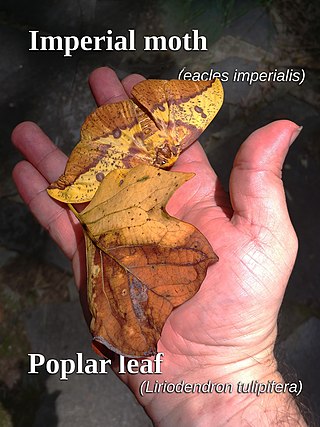
Eacles is a genus of moths in the family Saturniidae. They are native to the Americas. The genus was erected by Jacob Hübner in 1819.

Oxytenis modestia, the Costa Rica leaf moth, dead-leaf moth, or tropical American silkworm moth, is a species of moth in the family Saturniidae. It was first described by Pieter Cramer in 1780. It occurs from Guatemala to northern South America.

The Saturniinae or saturniines are a subfamily of the family Saturniidae, also known as giant silkmoths. They are commonly known as emperor moths or wild silk moths. They are easily spotted by the eyespots on the upper surface of their wings. Some exhibit realistic eye-like markings, whilst others have adapted the eyespots to form crescent moon or angular shapes or have lost their wing scales to create transparent windows. They are medium to very large moths, with adult wingspans ranging from 7.5 to 15 cm, in some cases even more. They consist of some of the largest sized Lepidoptera, such as the luna moth, atlas moth, and many more. The Saturniinae is an important source of wild silk and human food in many different cultures.

Arsenura armida, the giant silk moth, is a moth of the family Saturniidae. It is found mainly in South and Central America, from Mexico to Bolivia, and Ecuador to south-eastern Brazil. It was first described by Pieter Cramer in 1779.
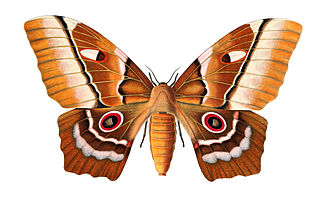
Pseudimbrasia is a monotypic moth genus in the family Saturniidae described by Pierre Claude Rougeot in 1962. Its only species, Pseudimbrasia deyrollei, described by James Thomson in 1858, is found in the mid-latitudes of Africa.

Rohaniella pygmaea, the pigmy emperor, is a moth of the family Saturniidae. It is found in Africa, including Namibia and South Africa. The species was first described by Peter Maassen and Gustav Weymer in 1885.
Gilles Terral was a French entomologist. He specialised in Lepidoptera Parnassiinae and Saturniidae.

Automeris is a genus of moths in the family Saturniidae and the subfamily Hemileucinae. As of 1996 there were 124 species, and more have since been described. These moths are generally characterized by the eyelike patches on the hindwings and the leaflike pattern on the forewings, an example of crypsis. The genus was first described by Jacob Hübner in 1819 and it is distributed in the Neotropical realm.

Imbrasia obscura is a species of moth belonging to the family Saturniidae first described by Arthur Gardiner Butler in 1878.

Syssphinx is a genus of moths of the family Saturniidae. The genus was erected by Jacob Hübner in 1819.

Aglia is a genus of moths in the family Saturniidae first described by Ochsenheimer in 1810. It is the only genus in the subfamily Agliinae.

Copiopteryx is a genus of moths in the family Saturniidae first described by James Duncan and John O. Westwood in 1841.

Gonimbrasia is a genus of moths in the family Saturniidae first described by Arthur Gardiner Butler in 1878.

Urota is a monotypic moth genus in the family Saturniidae erected by John O. Westwood in 1849. Its single species, Urota sinope, was described by the same author in the same year. It was described from KwaZulu-Natal, South Africa.
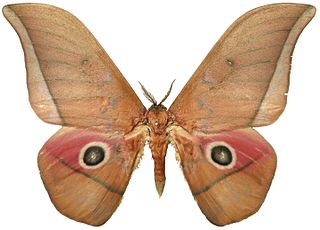
Lobobunaea acetes is a species of moth in the family Saturniidae first described by John O. Westwood in 1849. It is found in Angola, Cameroon, the Democratic Republic of the Congo, Guinea, Kenya, Nigeria, Rwanda, Sierra Leone, Tanzania and Uganda.
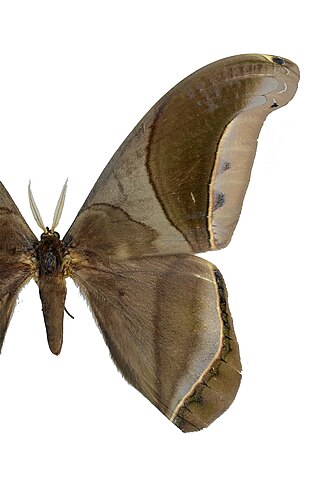
Rhescyntis hippodamia is a species of moth in the family Saturniidae first described by Pieter Cramer in 1777. It is found from Mexico to Brazil.
Cricula ceylonica, the Sri Lankan cricula silkmoth, is a moth of the family Saturniidae. The species was first described by Karl Jordan in 1909 and it is endemic to Sri Lanka. The debate of this species with much broader range circular species - Cricula trifenestrata is not yet fully understood. However, Rougerie et al., in 2009 considered Cricula ceylonica a valid species, probably endemic to Sri Lanka.
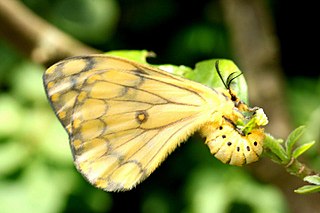
Pseudaphelia apollinaris is a species of moth in the family Saturniidae first described by Jean Baptiste Boisduval in 1847.

















